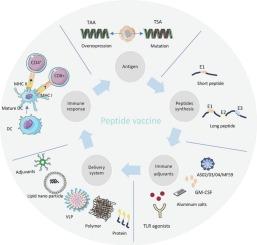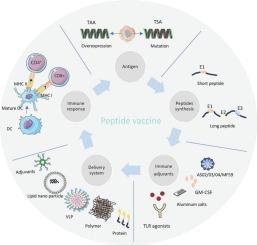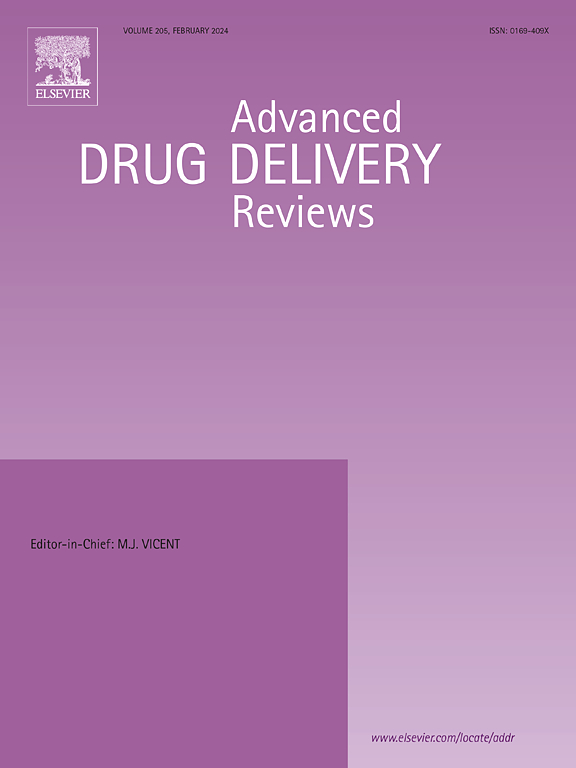Challenges and opportunities on achieving an adequate delivery efficiency and immunogenicity with peptide-based anticancer vaccines
IF 17.6
1区 医学
Q1 PHARMACOLOGY & PHARMACY
引用次数: 0
Abstract
Peptide vaccines are based on small peptide segments that contain antigenic epitopes recognizable by immune cells. Unlike traditional vaccines, they include only specific antigenic epitopes rather than entire pathogens or proteins. They are recognized, internalized, processed, and presented by antigen-presenting cells, such as dendritic cells, and subsequently presented to T cells, triggering an immune response. Peptide-based vaccines, an innovative regimen of cancer immunotherapy, have shown the potential to elicit target-specific anti-tumor immune responses, however their therapeutic efficacy is often diminished by their poor stability, rapid clearance from circulation, low immunogenicity, individual variability, and immune escape. In recent years, significant advancements have been achieved in the mechanism of action, design, and delivery of potent peptide-based cancer vaccines to address their limitations for clinical translation. Long peptide vaccines are more likely to induce antigen cross-presentation than short peptide vaccines. Tumor-specific peptide antigens and tumor-associated antigens have been developed to enhance anti-cancer immunogenicity. Incorporation of various delivery systems, such as lipid nanoparticles, polymers, and viral vectors substantially improve the stability of peptide antigens in circulation. Co-delivery of the peptide antigens and adjuvants further enhances with antigen presentation and T-cell activation, resulting in robust immunogenicity and efficacious cancer immunotherapy. Combination therapy of peptide vaccines and other therapies, including chemotherapy, radiotherapy, immune checkpoint inhibitors, and targeted therapy also enhances therapeutic outcomes. This article provides insights in cancer peptide vaccines, including the mechanism of action of peptide antigens and adjuvants, while discussing their challenges and opportunities, and exploring the use of delivery systems to improve their pharmacokinetics and therapeutic efficacies for cancer immunotherapy.


以肽为基础的抗癌疫苗实现足够的递送效率和免疫原性的挑战和机遇
肽疫苗是基于含有免疫细胞可识别的抗原表位的小肽段。与传统疫苗不同,它们只包括特定的抗原表位,而不是整个病原体或蛋白质。它们被识别、内化、加工,并由抗原呈递细胞(如树突状细胞)呈递,随后呈递给T细胞,引发免疫反应。基于肽的疫苗是一种创新的癌症免疫治疗方案,已显示出引发靶向特异性抗肿瘤免疫反应的潜力,但其治疗效果往往因其稳定性差、快速从循环中清除、免疫原性低、个体差异和免疫逃逸而降低。近年来,在有效的肽基癌症疫苗的作用机制、设计和递送方面取得了重大进展,以解决其临床转化的局限性。长肽疫苗比短肽疫苗更容易诱导抗原交叉呈递。肿瘤特异性肽抗原和肿瘤相关抗原已被开发用于增强抗癌免疫原性。结合各种递送系统,如脂质纳米颗粒、聚合物和病毒载体,大大提高了肽抗原在循环中的稳定性。肽抗原和佐剂的共同递送进一步增强抗原呈递和t细胞活化,从而产生强大的免疫原性和有效的癌症免疫治疗。多肽疫苗与其他疗法(包括化疗、放疗、免疫检查点抑制剂和靶向治疗)的联合治疗也能提高治疗效果。本文提供了对癌症肽疫苗的见解,包括肽抗原和佐剂的作用机制,同时讨论了它们的挑战和机遇,并探索了使用递送系统来改善它们在癌症免疫治疗中的药代动力学和治疗效果。
本文章由计算机程序翻译,如有差异,请以英文原文为准。
求助全文
约1分钟内获得全文
求助全文
来源期刊
CiteScore
28.10
自引率
5.00%
发文量
294
审稿时长
15.1 weeks
期刊介绍:
The aim of the Journal is to provide a forum for the critical analysis of advanced drug and gene delivery systems and their applications in human and veterinary medicine. The Journal has a broad scope, covering the key issues for effective drug and gene delivery, from administration to site-specific delivery.
In general, the Journal publishes review articles in a Theme Issue format. Each Theme Issue provides a comprehensive and critical examination of current and emerging research on the design and development of advanced drug and gene delivery systems and their application to experimental and clinical therapeutics. The goal is to illustrate the pivotal role of a multidisciplinary approach to modern drug delivery, encompassing the application of sound biological and physicochemical principles to the engineering of drug delivery systems to meet the therapeutic need at hand. Importantly the Editorial Team of ADDR asks that the authors effectively window the extensive volume of literature, pick the important contributions and explain their importance, produce a forward looking identification of the challenges facing the field and produce a Conclusions section with expert recommendations to address the issues.

 求助内容:
求助内容: 应助结果提醒方式:
应助结果提醒方式:


